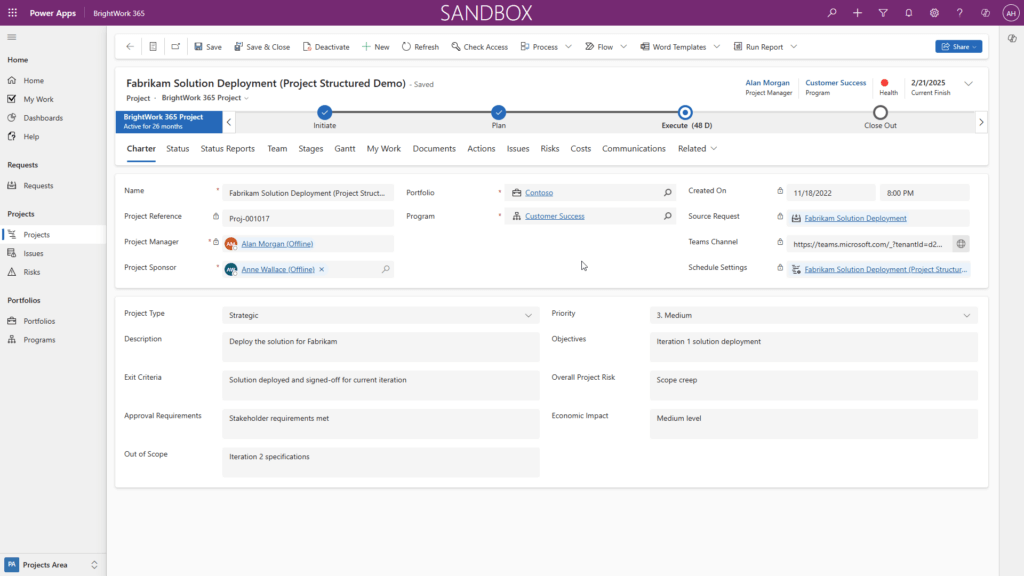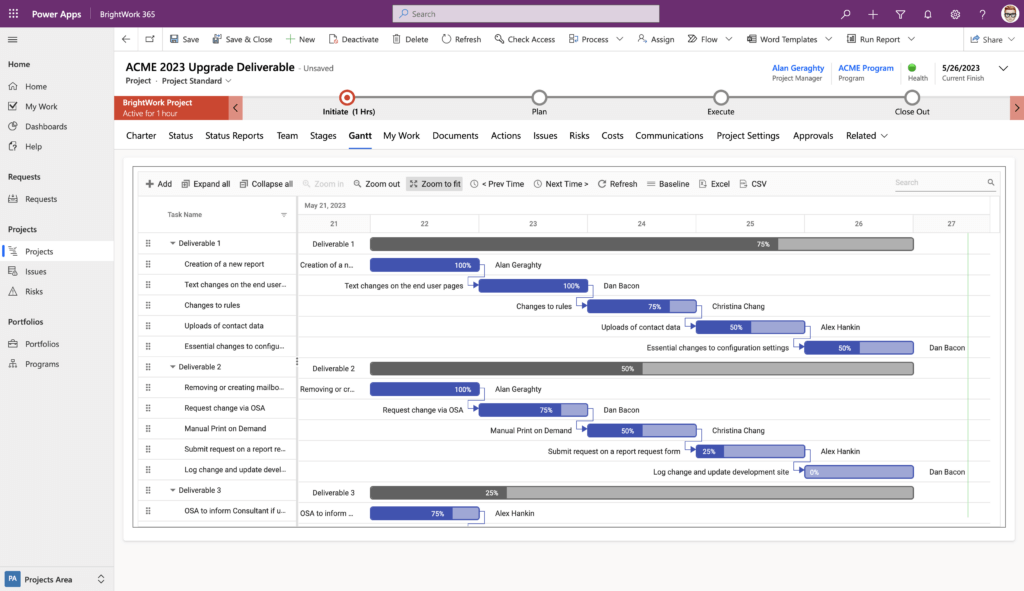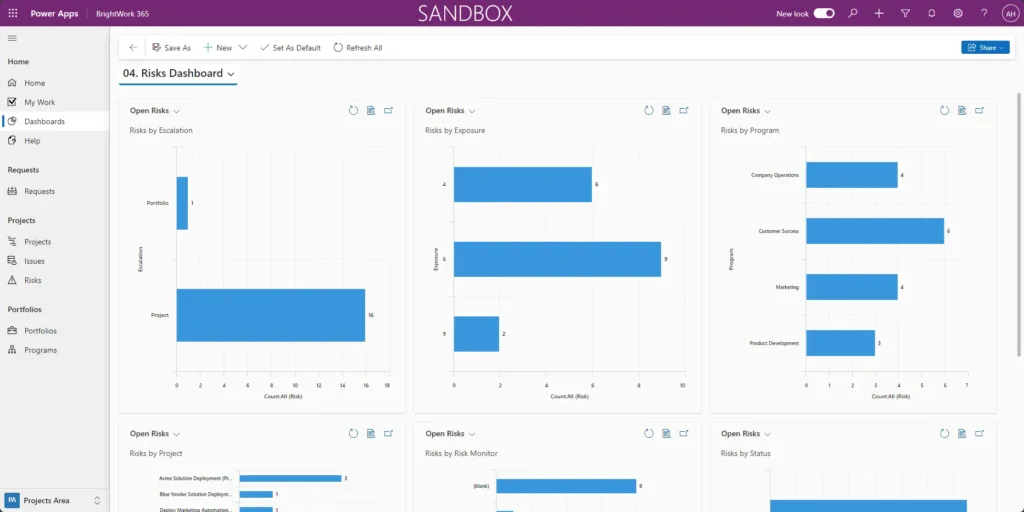BrightWork 365 helps you create and manage a comprehensive project management plan, which often starts with a simple project brief or a more formal project initiation document (PID).
This article will show you how to set up a new project using BrightWork 365. The process includes creating a channel in Microsoft Teams, adding resources, building the schedule, and logging risks.
Add a New Project Site in the Projects Area
Depending on the permissions set by your organization, you can start working on the project site created during the request process or select +New to create a new project.
Add key details, like the name of your project, the associated portfolio, and the project manager, to the form. Next, select a template for your project:
- Product Update – A template used to manage maintenance-related projects generated from support request submissions.
- Project Standard – A template for semi-structured waterfall projects.
- New Product Introduction – A structured template for developing a new product.
- Content Template – A template created from an existing project site.
These templates correspond to different approaches, allowing you to choose a project management framework that fits your needs.
For example, the ‘Project Standard’ template is ideal for a traditional waterfall project management methodology, while other templates can be adapted to incorporate principles from agile or scrum.
Define Project Scope and Objectives
Before documenting the charter, you need to establish the project’s foundation. This involves clearly defining the project scope to set boundaries and prevent uncontrolled changes.
You must also establish specific project goals and measurable project objectives. Identifying these elements and the primary success factors early on ensures alignment among all stakeholders and provides a clear basis for measuring performance.
Add a project charter

The project charter describes the project’s purpose, objectives, and expected benefits.
This information establishes the strategic importance of the project and ensures everyone understands what is in or out of scope.
In addition to details on the project manager and project sponsor, BrightWork 365 includes links to:
- The associated portfolio
- The associated program
- The original request
- The associated Teams channel.
To update the Charter, click into the relevant text box, make the changes, and click ‘Save’ in the ribbon.
Build your team

Next, add resources to your project by selecting ‘+ New Project Team Member’.
This step is an important part of resource allocation, where you assign the right people to the right tasks based on their skills and availability.
BrightWork 365 is connected to your Azure Active Directory, making it easy to find and add team members.
Add stages, tasks, and deliverables

It’s now time to build the schedule for the project. In BrightWork 365, tasks are managed in the ‘Gantt’ tab. A best practice is to first map out a work breakdown structure (WBS) to divide the project into smaller, manageable pieces.
Use ‘Add’ in the Gantt ribbon to add a new task, phase, or deliverable to the timeline.
Add more details to the task, like the owner, finish dates, and dependencies, using the ‘new task’ dialogue box. Defining these relationships helps establish the critical path for the project and track progress against important milestones.
Assigned tasks are added to the relevant team member’s work report, which helps in compiling regular status reports for stakeholders.
To edit a task, phase, or deliverable, select the item and click ‘edit’ in the Gantt ribbon, or double-click the taskbar. Both options open the dialogue box. Here, you can edit the item as needed, for example, updating the percentage complete on a task.
Manage documents with SharePoint Online

BrightWork 365 leverages SharePoint Online for document management.
During the installation and setup, a SharePoint site and accompanying document library were created. When you create or upload documents via the Document tab in the project site, the files are stored in this library.
Using the Documents tab, you can quickly:
- Upload existing files.
- Create a new Word, Excel, or PowerPoint file that opens in a separate browser tab for instant use!
- Add a new OneNote Notebook to the project.
BrightWork 365 offers light document management options such as Check In/Check Out.
To work with documents in SharePoint Online, access SharePoint in the Microsoft 365 app launcher or click ‘Open Location’ in the project site.
From here, you can use SharePoint Online features, including:
- Link sharing
- Permissions
- Version control
- Alerts
- Power Automate Flows, such as requesting a sign-off.
Add a Microsoft Teams Channel with Project Settings

Every BrightWork 365 Program can have its own Microsoft Team, and every project can have a channel within that team.
To add a Teams channel, click ‘Create Teams Channel’ in Project Settings. BrightWork 365 is accessible via the Charter tab. You can rename the tab as needed.
Your project team can leverage Microsoft Teams for project management, like instant chat and video meetings, alongside the project management processes in BrightWork 365.
Note – if a Microsoft Team wasn’t created for the program, ask your BrightWork 365 administrator to do so using the steps in this article.
Add known risks

During project planning, you likely identified risks with the project sponsor, stakeholders, and the team. Thorough project planning extends beyond risks to include broader issue management.
It’s a good idea to add these risks to the site during project setup. A best practice is to maintain a RAID log (Risks, Assumptions, Issues, Dependencies) to track all potential blockers. This way, the team knows what to look out for during project execution and can build in contingency time to the schedule.
Log the risk to the site and add more details as needed. Once the project begins, add more risks to the site and keep existing risks up-to-date.
Work Better, Together with BrightWork 365 for Microsoft 365
BrightWork 365 is a project and portfolio management app, deployed on the Microsoft Power Platform in your Microsoft 365 cloud environment.
BrightWork 365 combines the best elements of Microsoft 365, such as Microsoft Teams, Microsoft Power BI, and Microsoft Power Automate, with our proven project management processes.
Schedule your BrightWork 365 demo to explore how this solution can improve your project outcomes.

